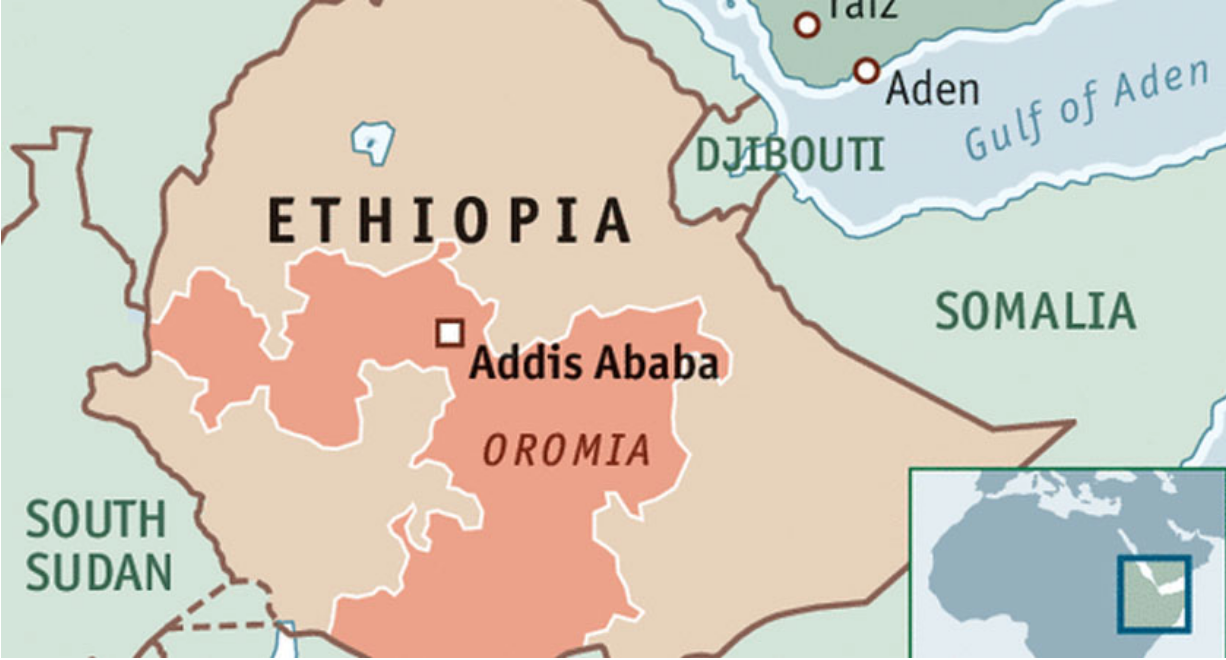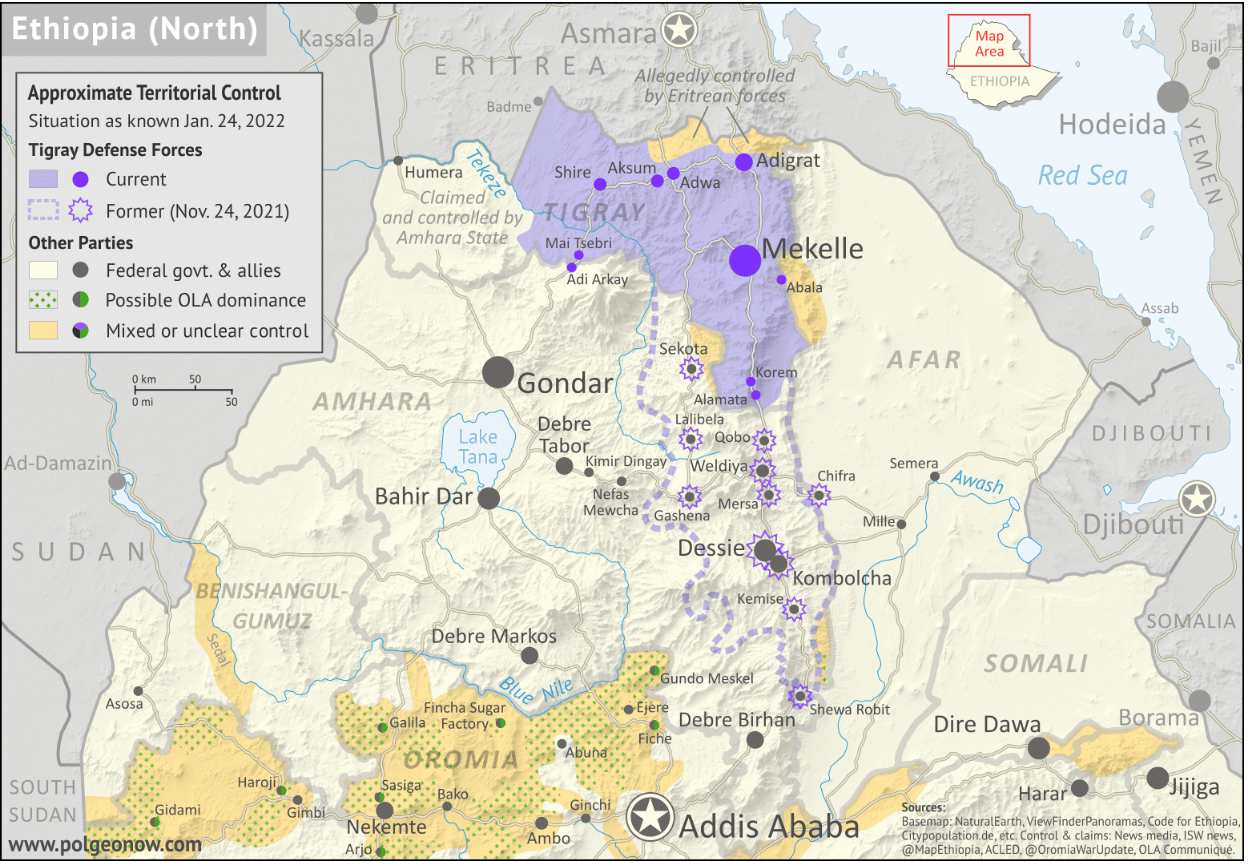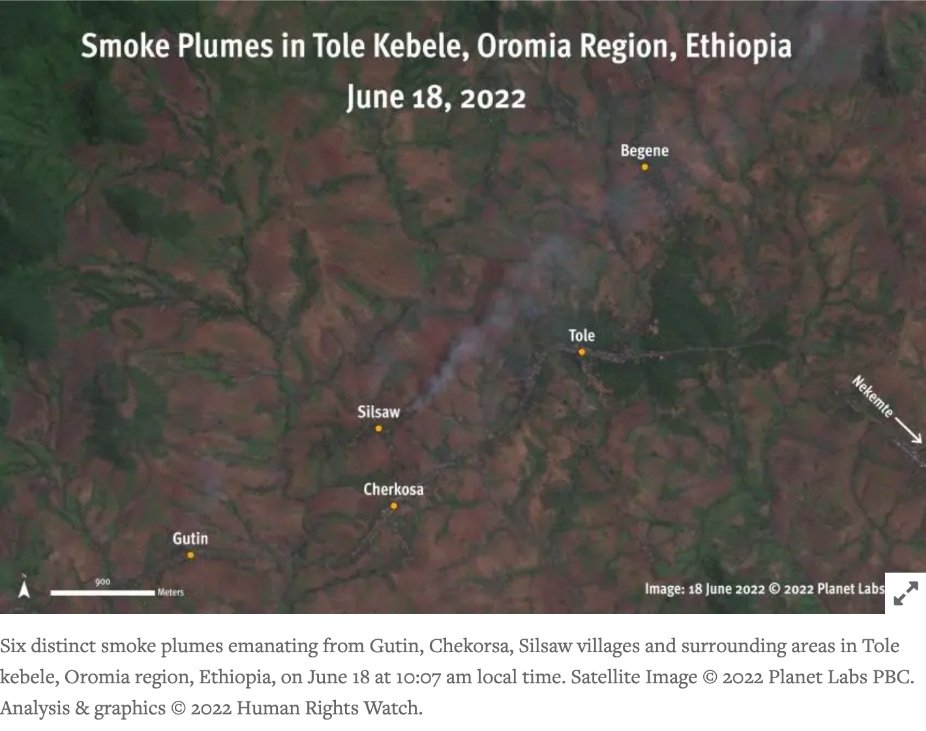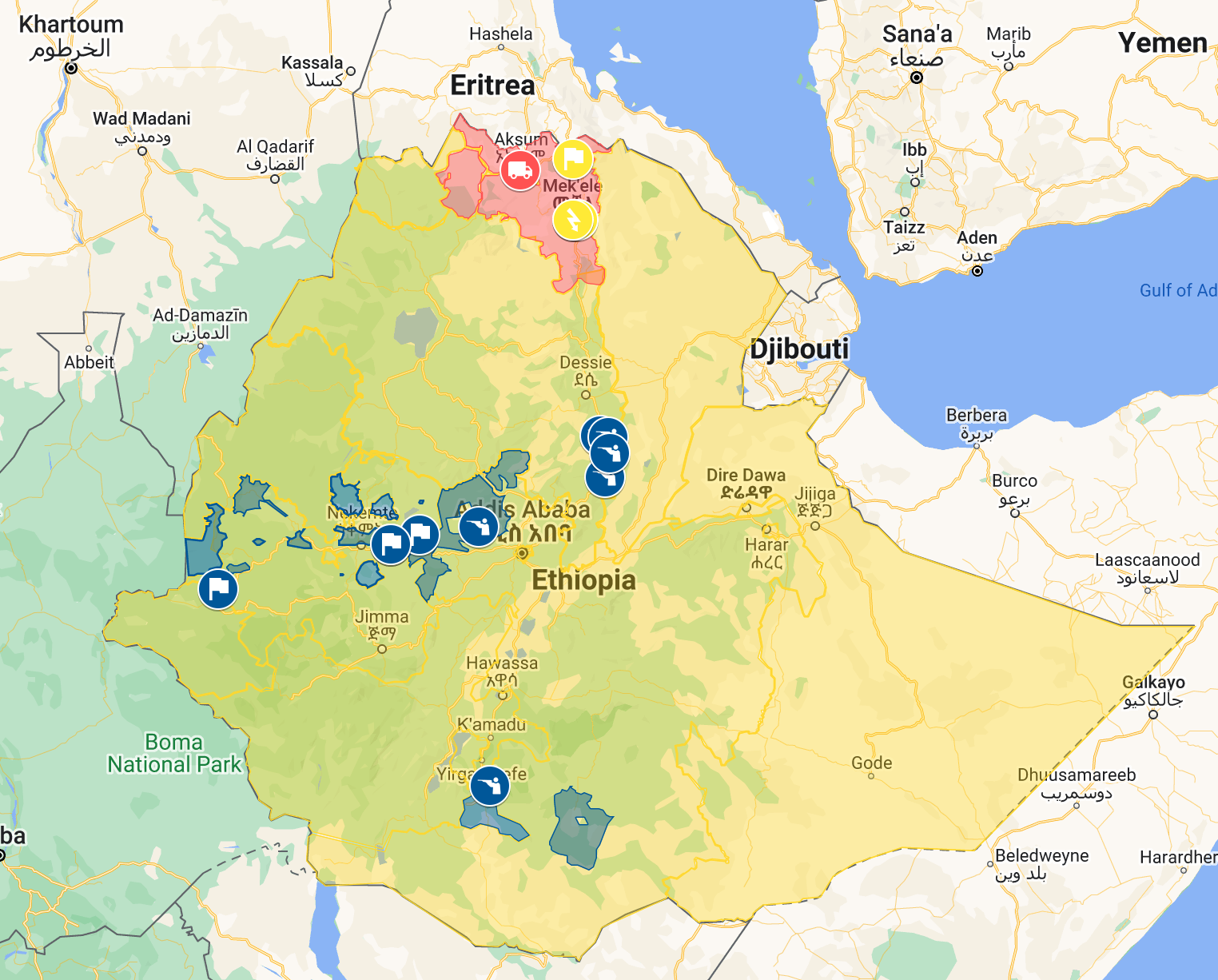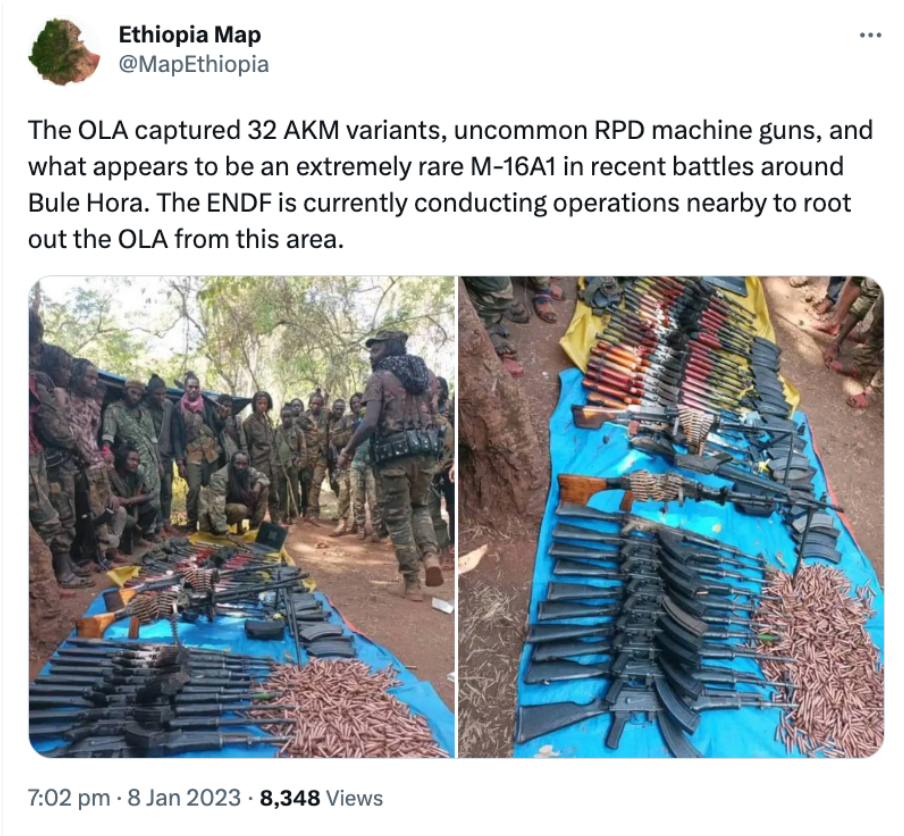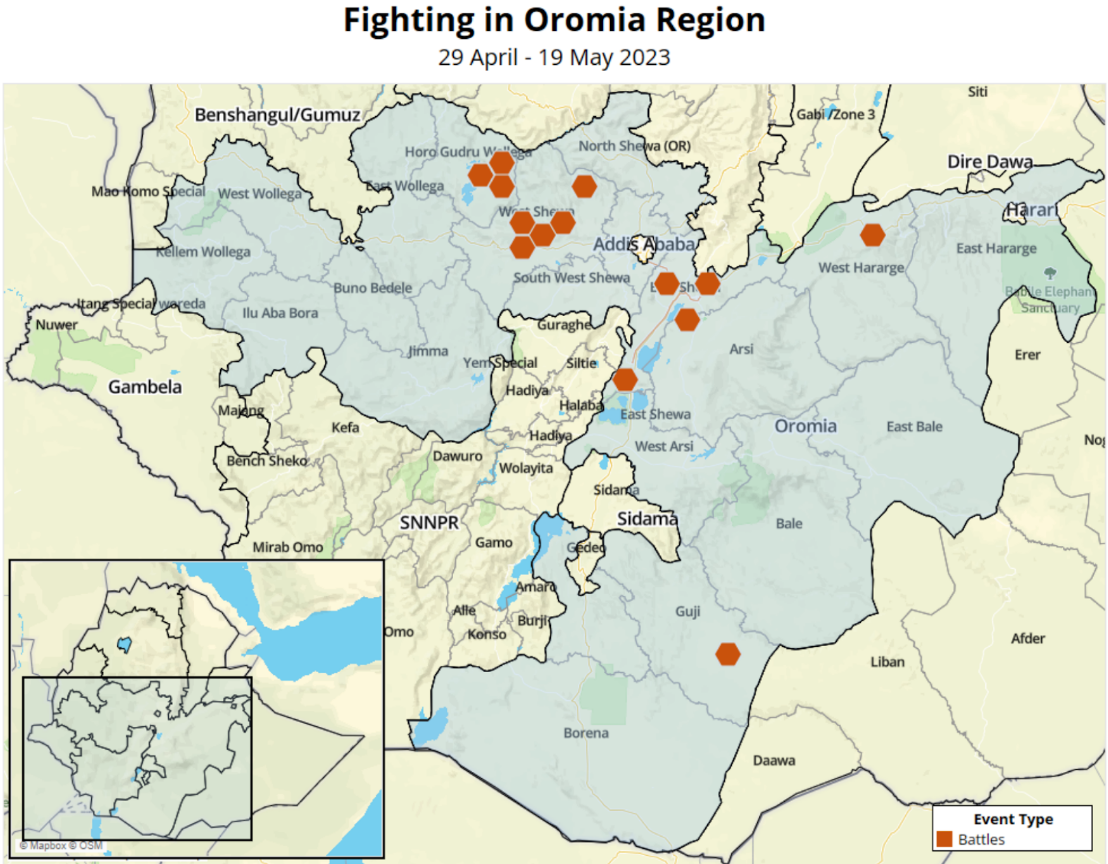Intelligence Report - From Pretoria to Oromia: A Comprehensive Analysis of the Oromia Conflict in Ethiopia
By: Annabelle Gouache
The war in Tigray challenged Ethiopia's position as a leader in promoting peace and economic stability in Africa. Widespread human rights violations attracted the attention of the international community and led to calls for accountability and action to end the conflict – achieved by the Pretoria Agreement of November 2022. Mediators have been monitoring the implementation of the peace accords in the north since then, but they have neglected the ongoing conflict in Oromia between the Ethiopian government and the Oromo Liberation Army. This article seeks to highlight why this conflict poses a major challenge to regional peacebuilding efforts and Ethiopia’s stability.
Tigray Civil War
The civil war between the Tigray People's Liberation Front (TPLF) and the Ethiopian National Defense Forces (ENDF), as well as forces from neighbouring Eritrea, began in November 2020 in the Tigray region. In 2018, tensions began as Abiy Ahmed was elected as Prime Minister and the TPLF – a political party that dominated Ethiopian politics for decades – accused the government of excluding them from the political process and attempting to centralise power.
The disagreements between TPLF and Abiy’s ruling coalition were mainly based on historical issues about the nature of ethnic federalism in Ethiopia, with tensions escalating in the fall of 2020 as Tigray held regional elections disregarding a federal postponement due to the COVID-19 pandemic. Finally, the catalyst for the federal government's full-scale offensive in Tigray was an attack by TPLF members on a military base in Mekelle, the capital of Tigray, on November 3rd which the TPLF described as a “pre-emptive strike”. The conflict was officially resolved with the signing of the Pretoria Agreement on November 2nd, 2022 in Pretoria, South Africa.
All parties to the conflict have been accused of violating international human rights law, with evidence of unlawful killings, torture, and sexual violence. Global Rights Compliances published an OSINT investigation in October 2022 in which it concluded that the Ethiopian government and allied regional authorities systematically deny humanitarian access and undermine food security in Tigray. The report also included findings by Bellingcat establishing the government’s responsibility in attacks on Shimelba and Hitsats refugee camps as well as an unlawful airstrike on a civilian market in Togoga.
As of late 2022, the combined impact of wartime violence, famine and a lack of humanitarian aid had killed an estimated 385,000-600,000 people according to independent scholars in Ghent University, with other reported estimates reaching numbers as high as 800,000 killed. Allegations were made about the provision of military support to the government by foreign powers further fueling violence. These included Wing Loong 2 UAVs manufactured by China, and TB2 weaponised drones supplied by Türkiye, Iran, and the United Arab Emirates.
The conflict has drawn international attention and concern, in great part due to the government's response to the insurgency in Tigray, which has consisted of a two-year internet blackout restricting information on war crimes, and concealing the true extent of the violence taking place. Similarly, limited humanitarian access has made independent assessments of the situation on the ground difficult, heightening the need for international action to address the crisis.
Shifting focus from Tigray to Oromia
As the conflict in northern Ethiopia has subsided with the signing of the permanent cessation of hostilities agreement in November 2022, the focus should now be turned to the Oromia region where the Ethiopian government has conducted a years-long campaign dubbed by the Oromia War, aimed at eliminating the Oromo Liberation Army (OLA) since December 2018.
The Oromos are Ethiopia’s largest ethnic group, but they have faced a long history of persecution at the hands of successive governments. The Oromo Liberation Front (OLF) was created in 1973 with the goal of promoting Oromo nationalism and fighting for political, economic, and social rights for the Oromo people.
The OLA became an active armed wing of the OLF in the 1990s, and its current version emerged in 2018 after the OLF signed a peace agreement with the government and made a commitment to integrate the military wing into the regional armed forces. The OLA refused and has since been involved in a low-level insurgency since then with attacks on government officials and installations, as well as clashes with other ethnic groups in the region. The Ethiopian government refuses to call the OLA by its chosen name, instead referring to it as Shene, Oneg or OLF-Shene (Oromo: Shanee, lit. 'five').
The region stretching across Ethiopia from east to west is home to over 37 million people and has been the most volatile region in the country, particularly between November 2022 and February 2023 due to the armed clashes between the OLA and government security forces. The Oromia region surrounds Addis Ababa, making stability in this region essential for the whole country and the Horn of Africa as a whole.
Oromia Region, surrounding Addis Ababa, the capital of Ethiopia, by Tesfanews (2017).
OLA Insurgency
In 2016, a large Oromo youth movement called the Qeerroo social movement was instrumental in the peaceful transition that brought PM Abiy Ahmed to power in 2018 as he is Oromo himself. In this context, the departure of the TPLF after decades in power and the arrival of an Oromo politician generated high hopes of democratisation and political representation in the region. However, these expectations were thwarted by the government as Abiy Ahmed’s government bolstered repressive tactics to combat the OLA and failed to address the socio-economic grievances of the Oromo youth.
These are some of the most significant developments:
In December 2018, the PM declared a de facto state of emergency in the Oromia region and installed military posts in western and southern Oromia with the mission of coordinating different national and local authorities to eliminate the OLA. The mission failed and instead promoted abuses against civilians, with Amnesty International documenting extrajudicial killings and arbitrary arrests.
In June 2019, Abiy Ahmed declared that the Qeerroo movement posed the “number one” potential threat to his power. Since, troops targeted youth leaders in Oromia such as Jawar Mohammed which reignited mass street protests in October 2019.
On 22 February 2020, members of the Oromia Police Special Force were involved in the unlawful killing of a vendor as they forcefully dispersed an assembly, and beat artists they accused of supporting the OLA.
In June 2020, further escalation of violence ensued following the assassination of Hachalu Hundessa, a famous Oromo singer and activist. The protests resulted in the death of at least 239 people.
Against this background, the OLA took advantage of that federal troops were engaged in a full-scale war in Tigray and rose in prominence towards the end of 2021 as they claimed to have captured towns and villages in western and southern Oromia. Overall, the allegation of OLA territorial control seemed more credible in the west than in central Ethiopia as the authorities in the capital did not seem threatened by OLA’s operations. It is worth mentioning, however, that on August 11, 2021, the OLA formed a military alliance with the TPLF to fight against the government. OLA supported TPLF’s offensive attack which almost reached Addis Ababa in late November 2021 causing the government to declare a state of emergency (see map below).
Ethiopia War Map: Tigray Rebel Advance on Capital & Control Today (Nov. 2021/Jan. 2022). Map by Evan Centanni and Djordje Djukic, published on Political Geography Now.
In contrast with the war in Tigray, the OLA members have been fighting in small units rarely involving artillery or other heavy weapons. Only one incident involving alleged OLA members using artillery and explosive weapons has been reported in the last year. The Ethiopian Human Rights Council argued that, on June 18, 2022, at least 300 people were killed in Gimbi, Wollega, in an attack targeting ethnic Amharas. Although the fighting is conducted with small arms rather than artillery, the conflict has been extremely deadly with ACLED recording 5,741 fatalities involving the OLA since April 2019.
OLA fighters have been mainly seizing weapons from federal troops to increase their arms supply. For instance, OLA fighters were photographed with Iranian KL-103 and "Hoshdar-M" assault rifles; Turkish EKOL P29 Blank pistols; and Azerbaijani 40M10 mortar bombs.
In April 2022, the government launched a new large-scale military offensive in Oromia starting in Moyale, Borana zone, at the border with Kenya – an area that has been hit by the worst drought in 40 years in East Africa. The military offensive fueled the conflict causing widespread human rights abuses perpetrated by both sides. For example, on 18 June 2022, OLA was accused of massacring over 500 civilians in the Tole Kebele, Gimbi county of Oromia (see photo below). Witnesses interviewed by Amnesty International said that the OLA intentionally targeted the Amhara people (the country's second-largest ethnic grouping). A Human Rights Watch report of the incident adds that the attack was facilitated because government forces left the area without explanation the day before. OLA has always denied these allegations and instead blamed government forces.
This alleged attack on the Amhara ethnic groups is part of several acts of violence against the Amhara population, particularly since Amharan militias became allies of the Ethiopian armed forces to fight the TPLF.
From November 2022 onwards
The federal government’s repeated operations in Oromia fueled the conflict and exacerbated inter-ethnic violence and enabled OLA’s troops to gain momentum within the Oromo population. In 2018, it was estimated that OLA had around 2,800 fighters and many estimate that the number has increased substantially since 2020 with “more and more Oromos [...] joining the rebel group as security and human rights protections in the region crumble”. Since the signing of the Tigray peace agreement in November 2022, the OLA has launched several attacks focusing on towns and villages west and north of the capital. @MapEthiopia on Twitter provided regular monitoring of key developments of the conflict in Tigray as well as in Oromia.
Google My Maps “Crisis in Ethiopia” last updated on February 16, 2023.
These are some of the actions the OLA has taken against the government.
November 2022:
1st: OLA launched new attacks against government forces across several areas in central/western Ethiopia. The capture of the towns of Mendi and Kiltu Kara is confirmed visually with a base being captured in Kiltu Kara.
2nd: the government launched drone strikes on Bila, killing dozens of civilians.
6th: intense fighting was recorded in Nekemte.
15th: OLA has taken Gundo Meskel after fighting with forces.
25th: OLA took Mulo which is under a 2-hour drive away from the capital.
December 2022:
27th: OLA claims to have killed and wounded dozens of ENDF troops in West Guji during fighting.
28th: the OLA is present in Meta Robi again, less than 3 hours away from the capital.
January 2023:
8th: OLA captured assault rifles and machine guns in recent battles around Bule Hora, southern Oromia (see Tweet below).
21st: OLA fighters remain around Bule Hora despite recent ENDF clearance operations in the area. A new attack resulted in the capture of 3 soldiers as well as 11 assault rifles, ammunition, and grenades.
23rd-25th: OLA was involved in fighting across North Shewa and Oromia special zones in Amhara against other rebel groups, resulting in 98 civilians killed, and 155 people injured.
26th: OLA released a photo of captured weapons after an attack on an ENDF camp in the town of Gedeb at the border of Oromia region. The OLA also released rebels from 2 prisons, looted weapons, and broke into 6 banks.
February 2023:
2nd-4th: according to the Ethiopian Human Rights Commission (EHRC), OLA killed over 50 people including a regional official, politicians, and militias as well as civilians in an IDP camp in Ano, a town of the East Wollega zone. EHRC said the killings targeted ethnic Amharas.
It is worth noting however that most of the OLA’s claims of territorial gain seemed rather unsubstantial as the OLA targets relatively easy areas to avoid tough fights for control. Their alliance with TPLF enabled them to get closer to the capital but now that the TPLF troops are being demobilised, it remains to be seen whether the OLA will be able to make significant progress against the federal troops.
Likewise, violence and territorial advances in Oromia are difficult to attribute as violence is also carried out by the Amhara Fano militia, criminal gangs, and ethnic Oromo youth claiming to be members of the OLA without having official links to the group (for a full list of the key actors, see the ACLED-EPO dataset). The Washington Post reported on May 21st of 2023 that some attacks on Amharas had been carried out by a rival militia led by Fekade Abdissa – a former OLF member.
Therefore, the aggregation of several unorganised actors affiliated with the OLA's actions may also cast doubt on whether the OLA becomes an orchestrated rebellion or a mere amalgam of groups looking to destabilise the region. This difference in perception may also influence whether the OLA enjoys as much credibility as the TPLF had at the negotiation table. The fact that the OLF has repeatedly dissociated itself from the rebel group is a further obstacle to the OLA’s political aspirations and hopes of legitimacy.
Fight for political recognition and peace
The army announced on January 3rd 2023 that it was launching a new offensive to eliminate OLA in the southern part of Oromia. However, a growing number of members of Parliament are calling for a peaceful resolution of the conflict to be made in a similar manner to that in Tigray. On February 17th, the regional administration made an unprecedented call for the “OLF-Shane to peacefully end hostilities and start negotiations”. The OLA responded in an open letter that they were ready to negotiate peace but insisted on the presence of third parties and the need to be addressed as OLA not by OLF-Shene by the authorities. Before engaging in peace talks, OLA leadership was presumably waiting to see whether the implementation of the Pretoria Agreement for Tigray was fulfilled by the government, and to assess the effectiveness of external monitoring by third parties such as the UN and the African Union.
These initiatives led to the first round of peace talks between government officials and OLA between April 24th and May 3rd, mediated by the regional Intergovernmental Authority on Development (IGAD), in Zanzibar. ACLED suggested that the peace talks between the OLA and the government may have started prior to April as events involving the OLA dropped sharply after a spike in November and December 2022. Similarly, the OLA published a manifesto in 2023 in which they enumerated their demands and concluded that “The End Must be Peace & Justice”. Amongst many measures including the involvement of credible and neutral mediators, they proposed Confidence Building Measures and Security Building Measures to address the current insecurity. Both sides confirmed the talks were productive, and remained committed to the peace process in spite of not reaching an agreement. One key issue was the government’s refusal to agree to the OLA's request for a transitional administration in the region of Oromia. According to their manifesto, establishing a transitional government is crucial to guarantee fair elections and uphold the principle of self-determination.
Renewed fighting spoils peace prospects
In spite of these positive developments, the intense fighting was reported by the media and by the OLA since May 7th in East Shawa, West Shewa, West Arsi, West Hararghe, Horo Guduru, and Southern Oromia. In total, ACLED recorded 18 battle events involving the OLA and government forces in the region (see map).
On May 15th, locals accused government forces of burning houses belonging to individuals suspected of sheltering OLA fighters, and on May 17th, the OLA accused the government of launching a military offensive against them. On May 20th, the OLA broke into a prison and released dozens of Oromo prisoners in the Arsi Zone of Bokoji town. The government never responded to confirm or reiterate its commitment to de-escalation and peace talks, thus casting doubt on its willingness to seek peace.
A second round of talks was expected to start on May 28th, however, the possibility of a second round of discussions happening soon seems improbable due to the allegations of government offensives, which have increased distrust among the parties involved. This lack of trust is further exacerbated by the government's failure to address these allegations openly. Abiy may perceive the establishment of a transitional government as risky since the current ruling coalition is fragile and Oromia holds significant political importance as a key constituency. Therefore, sharing power could potentially undermine the regional influence of his Prosperity Party.
Looking forward
The humanitarian, political, and economic costs incurred by the war in Tigray led to the belief that Ethiopia's problems stemmed primarily from this one conflict. However, the alliance between the TPLF and the OLA indicates a more intricate crisis unfolding in Ethiopia, as ethnic groups such as the Oromo and Amhara people experience socio-economic grievances.
To effectively address the ongoing peacekeeping efforts in the northern region, a more comprehensive approach is required. The international community's response and involvement in resolving the conflict in Oromia will have a pivotal role in shaping the future trajectory. Mediators should exert pressure on Abiy Ahmed's government to pursue credible peaceful solutions to bring an end to the Oromia conflict. It is apparent that sustained pressure from the African Union and broader international engagement will be necessary, as recent history suggests this conflict is unlikely to cease without such efforts.
While the Pretoria peace agreement between the Tigrayan forces and the Ethiopian government is a promising step toward stability and power-sharing, its applicability in Oromia remains uncertain. The disarmament of the TPLF forces and the relative peace achieved in Tigray through the peace-building framework must be evaluated for its potential adaptation in Oromia. This approach should address the underlying socio-economic grievances of the Oromo population, ensure respect for human rights, and facilitate meaningful political dialogue.

